Brazil take on Chile tonight at 1 am UK time at the Estádio Olímpico Nilton Santos in Rio de Janeiro in what is likely to be a very interesting quarter-final of the Copa America.
Brazil managed to get out of the group stage rather unscathed, winning three of their four games in Group B. Tite’s men only dropped points in the final match against Ecuador but the starting eleven was heavily rotated.
Chile, on the flip side, finished fourth out of five teams in Group A. However, it must be noted that Group A featured Argentina, Uruguay, and Paraguay and was a much more difficult group than Brazil’s. Worryingly, Martín Lasarte’s side only picked up one win from the four games, although they also lost just once too. The Chileans did muster hard-fought draws against Argentina and Uruguay too though so there have been positives to take.
Brazil are the heavy favourites going into this one but perhaps an upset could be on the cards providing Chile can nullify the hosts’ attacking threats and exploit their weaknesses.
This article will be a tactical analysis preview of the Copa America quarter-final between Brazil and Chile. It will be an analysis of the tactics both sides will likely deploy as well as how they can win the game.
Predicted lineups and formations
Predicting Brazil’s starting lineup and formation choice for this game was incredibly difficult considering Tite has shown to be very flexible with his choice of system as well as what personnel are utilised.
Brazil have used three different formations in their four games so far. The 4-4-2 has been used in 50 percent of Brazil’s matches whilst the remaining 50 percent is split between the 4-3-1-2 and the 4-2-3-1. For this game though, the 4-4-2 is the likeliest formation choice and tends to suit most of Brazil’s players very well apart from one or two who find themselves playing in an irregular position.
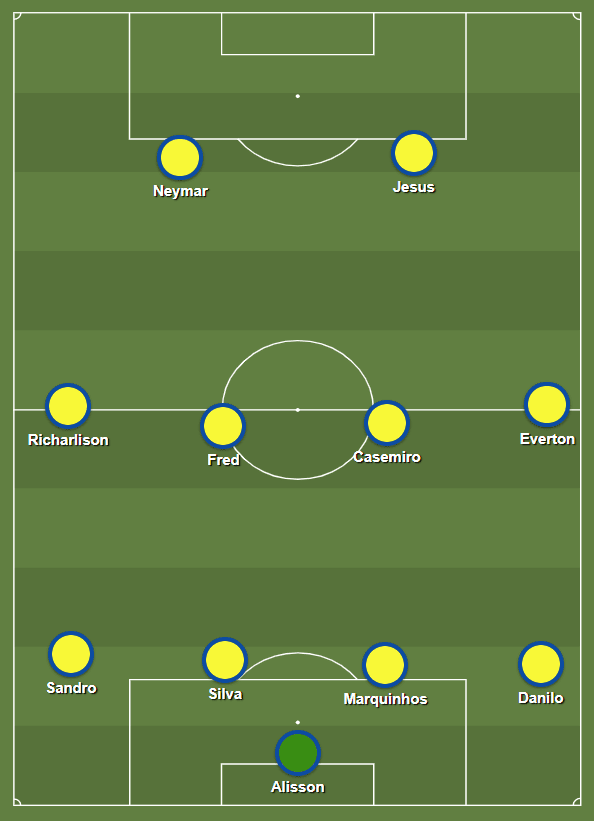
This is likely to be Brazil’s starting eleven against Chile. There are multiple other possible players who could also start though. Renan Lodi may start at left-back instead of Alex Sandro or else Danilo will be utilised as a left fullback and new Barcelona signing Emerson could be given the nod.
Alisson seems to be Tite’s preferred goalkeeper but Ederson has a good chance of starting too. In a double-pivot, Fred and Casemiro have formed an unlikely but quality duo, however, Liverpool’s Fabinho is another option on the bench that the manager may look to.
Up front was the most difficult area to choose. Neymar is a certain starter in the strike partnership but Tite will need to decide between Roberto Firmino, Gabriel Jesus, and Gabriel Barbosa, but the Manchester City man seems to be his preferred choice.
The Chilean starting eleven and formation were even more difficult to predict given how much rotation occurs from Lasarte.
The 4-3-3 has been the most used formation by the Chilean’s, but it has only been deployed in 20 percent of their games. This means that the other 80 percent has been rotated between the 4-4-2, 4-1-4-1, 3-4-3, 3-5-2, and 4-2-3-1, so it will be very tough to predict what Lasarte will do.
However, against better opposition, the 60-year-old tends to switch to a back three and since Brazil are the best team at the tournament, it is likely that the 3-5-2/5-3-2 is Chile’s formation choice for Saturday’s bout which can easily change to a 3-4-1-2 in possession depending on the situation.
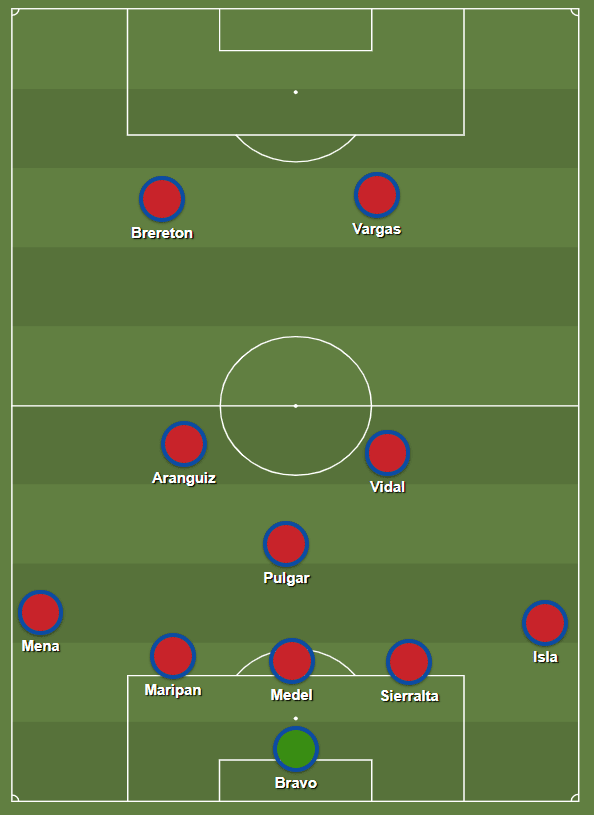
This will most likely be Chile’s starting eleven against Brazil. Truth be told, there looks to be little quality on the underdog’s bench so this could well be their strongest eleven. Cadiz midfielder Tomas Alarcon may be given the nod in midfield ahead of Erick Pulgar but that may be the only change to this starting eleven.
Claudio Bravo may start in goal behind a back five made up of Eugenio Mena, Monaco defender Guillermo Maripan, Gary Medel, Watford centre-back Francisco Sierralta, and former QPR wide man Mauricio Isla.
The three-man midfield which provides perfect balance tactically and technically is Pulgar, Charles Aranguiz, and Arturo Vidal whilst Blackburn Rovers striker Ben Brereton may partner alongside another former QPR player Eduardo Vargas up front. Alexis Sanchez is a huge loss for the Chileans.
Chile must remain disciplined when engaging in the midfield
When in the defensive phases of the game, Chile tend to remain quite proactive, particularly in the midfield, and are always looking to engage in duels to prevent ball progression by pressing face on. Chile have averaged 9.77 Passes allowed Per Defensive Action (PDDA) so far in their four matches at the Copa America, one of the lowest, which shows a willingness from them to press.
Chile tend to push their midfield players out to pressurise the opposition’s backline or pivot players but leaves space behind the midfielder to be exploited. Against Brazil, this can be quite a hindrance due to Brazil’s quality in their team with a plethora of players who can play line-breaking passes.
Lasarte’s men must suffocate spaces between the lines instead of leaving space, as this is where the Brazilians like to occupy and create good passing angles.
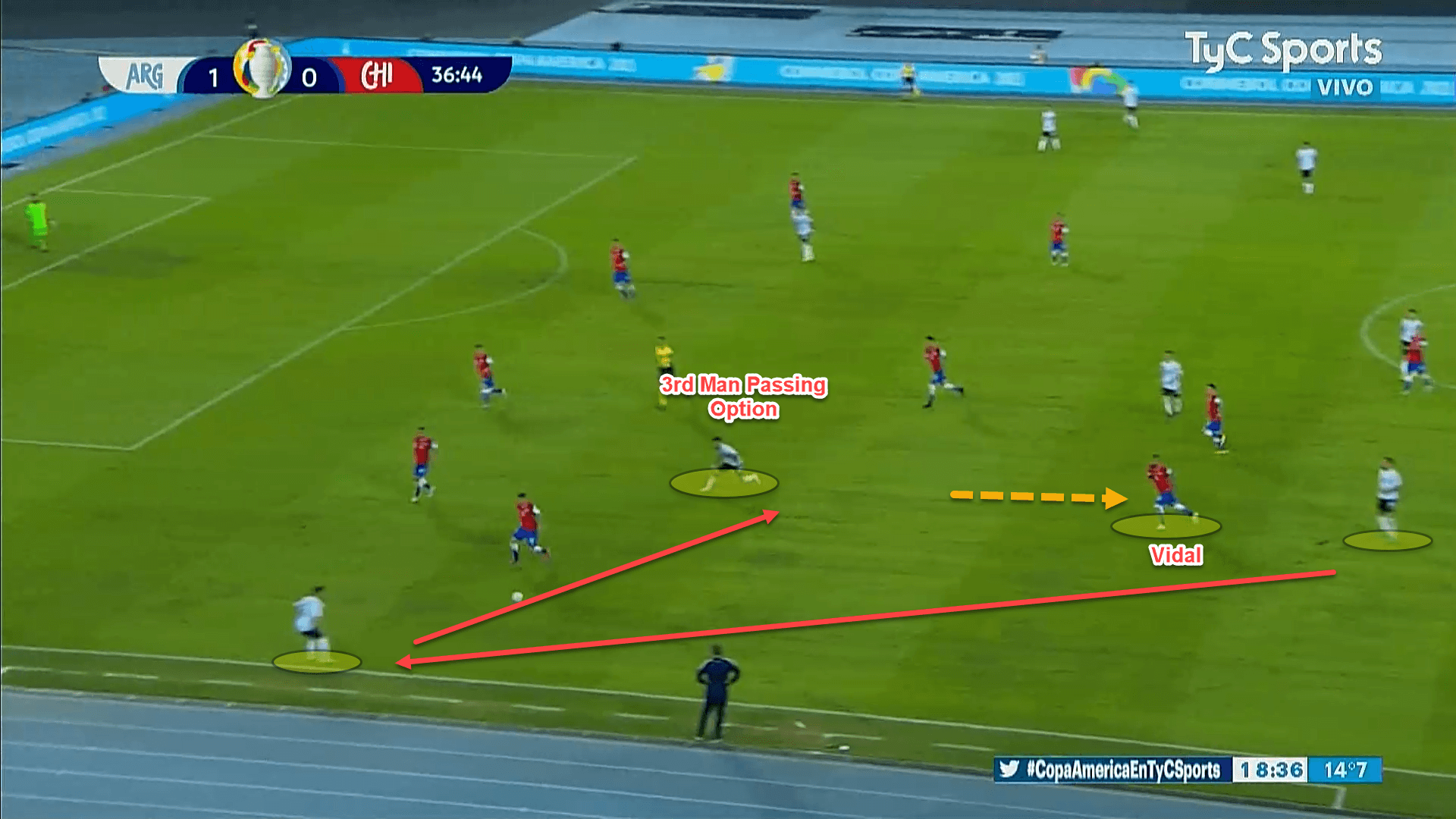
In this scenario, Vidal has pushed out of the midfield line to pressurise Argentina’s Nicolas Otamendi, leaving space behind him for a third-man pass to exploit. The former Manchester City defender has bypassed Chile’s first line of pressure, triggering Vidal to push out.
The centre-back then plays to the feet of the fullback who can bounce the ball back inside towards the inverted winger, allowing for quick and easy progression to the area between the opposition’s midfield and backline.
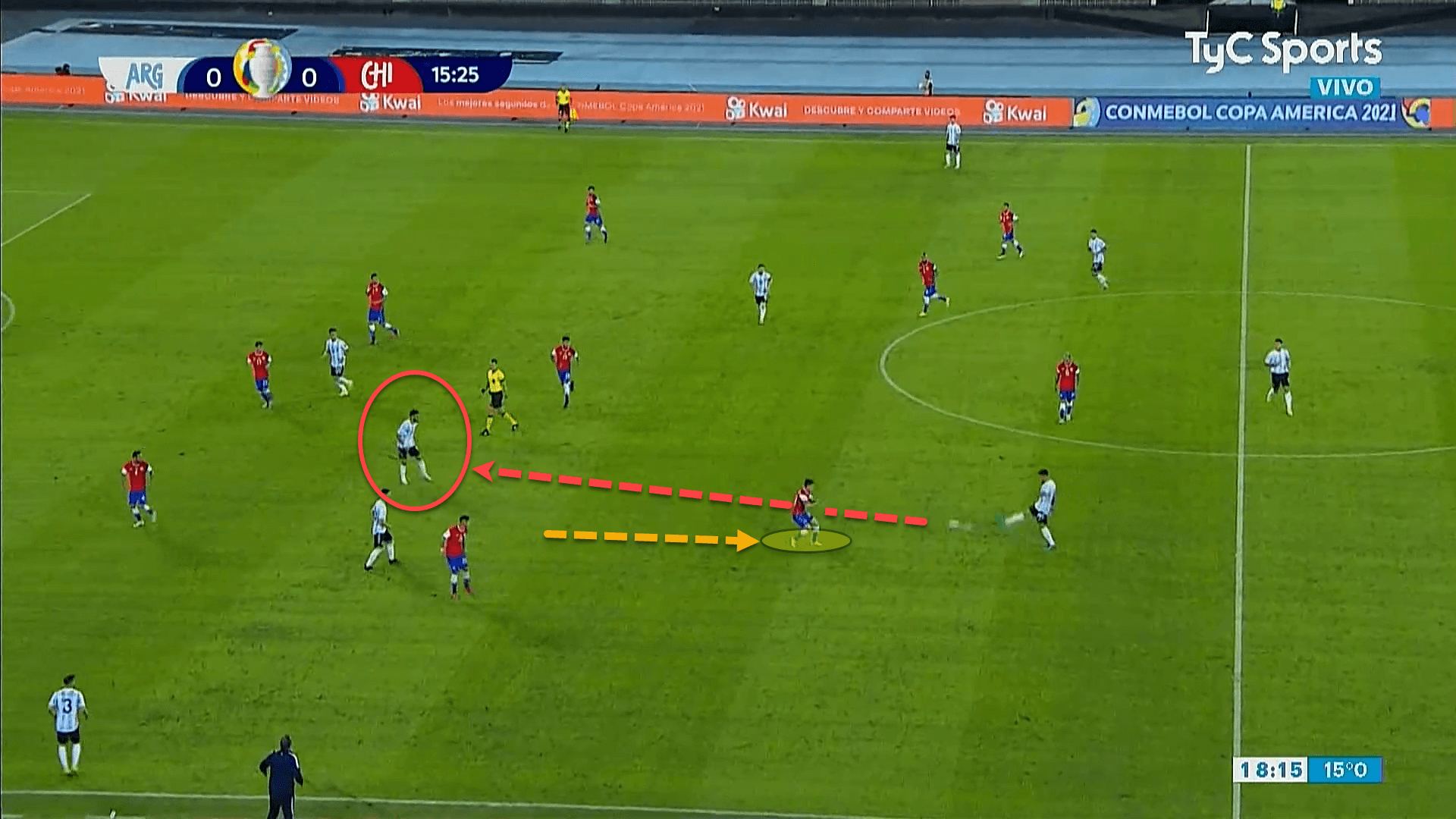
We can see a similar situation in the image above but this time, Argentina have managed to play the ball directly through Chile’s second line when the ball-near midfielder has closed down the ball-carrier.
Scenarios like this will be taken advantage of by Tite’s side due to their quality in possession – just like Argentina did in the previous two images – and so when situations arise where Brazil break Chile’s first line of pressure, it would be wise of Lasarte to instruct his men to drop off into a deeper block and defend their 18-yard box as opposed to the midfielders engaging with the ball-carrier, leaving gaps behind to be exploited.
When Chile do drop off, the space between the lines will be compacted and Brazil will find it much more difficult to break them down, which could be a very efficient way of nullifying their opposition’s star-studded attack as it will cut off the ball supply into players like Neymar in this areas and they will be forced to drop deeper to receive.
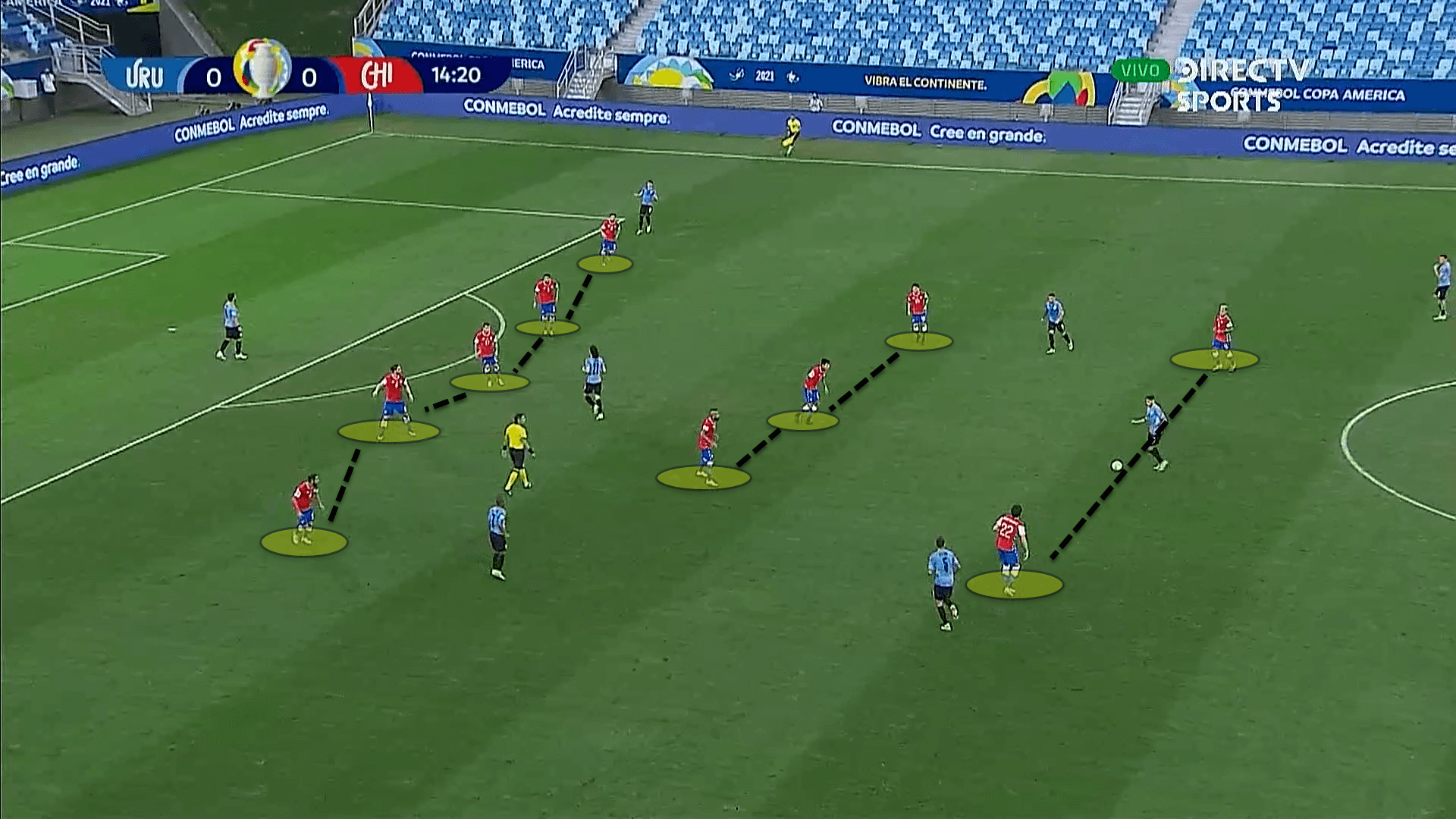
In Chile’s 3-5-2, they drop off into a 5-3-2 compact low block. As stated before, this will reduce space between the lines, as can be seen above, but will leave a lot of space in the wide areas which is another area Chile need to defend.
Brazil’s play down the flanks
When in the final third, Brazil like to use the width of the pitch to stretch the opposition and put crosses into the box. 7 of Brazil’s 10 goals so far in the tournament have come from situations where the ball has been crossed both on the ground and in the air.
Brazil’s players have also scored three times with their heads which is more than any other team in the competition, despite not having a very aerially dominant centre-forward.
When they have established possession around the halfway line, their systemic structure allows them to create overloads to attack down the flanks, particularly on the left. Brazil have put more crosses into the box from the left flank with 53 so far, more than any other nation at the Copa America.
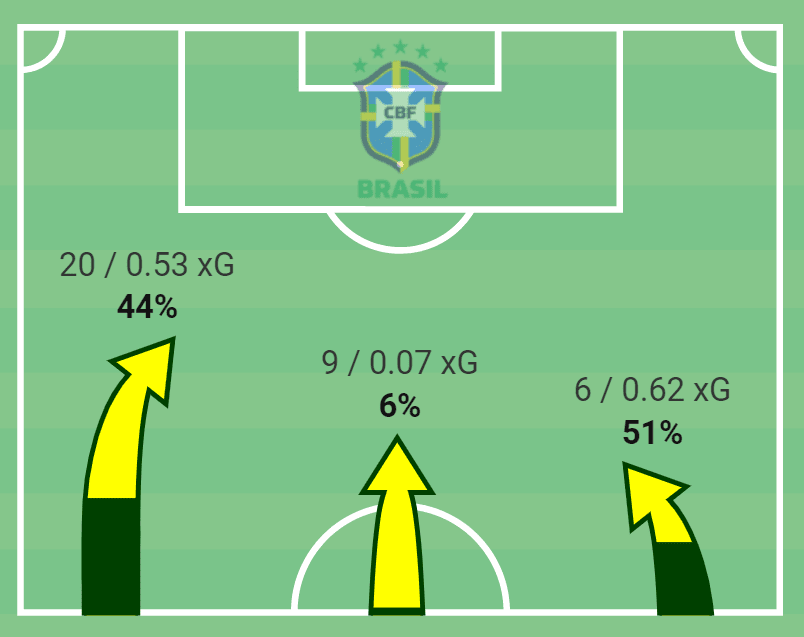
The data above represents all 35 positional attacks that Brazil had in a recent game against Colombia where they came out 2-1 victors. 26 of the 35 sustained attacks occurred down the flanks with exactly 20 happening on the left.
As stated, Brazil’s structure in possession allows for them to create overloads down the left, with the quality they have, and then they can break through the opposition’s defensive block in these areas and put balls into the box for the forwards to attack.
They do this by dragging one of the midfield pivot players out to the left flank, which allows for the left-back to venture further the forward whilst the winger inverts into the halfspace. This is called a wide rotation and creates a triangle on the flanks. Fred has done this role very efficiently under Tite.
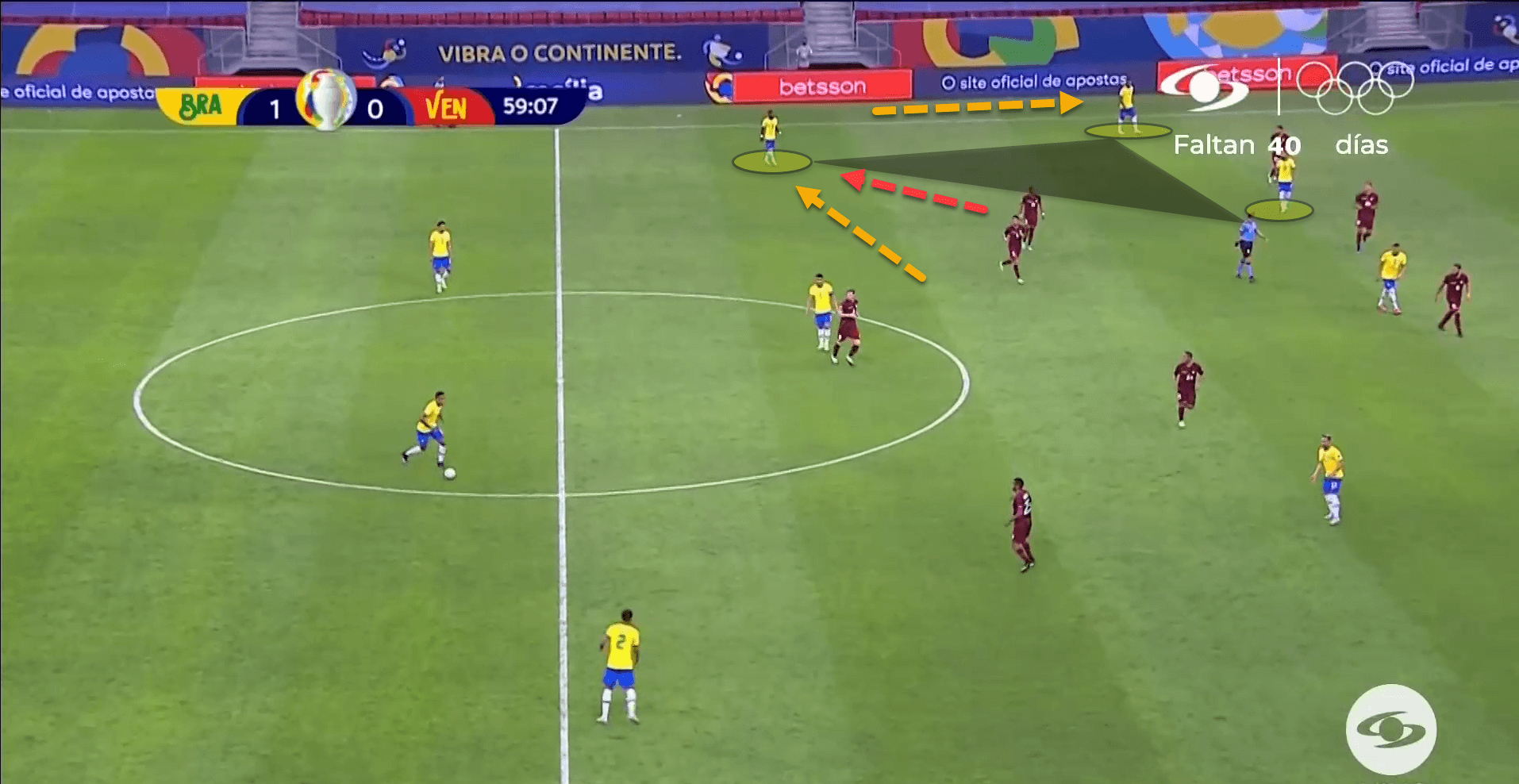
Fred vacating the central spaces and dropping out to the left flank can be seen in the image above. By moving out here, the possibilities are two-fold.
Fred is stretching the opposition’s midfield line which will create gaps in the opposition’s midfield to play through and find players between the lines to progress the ball further up the pitch.
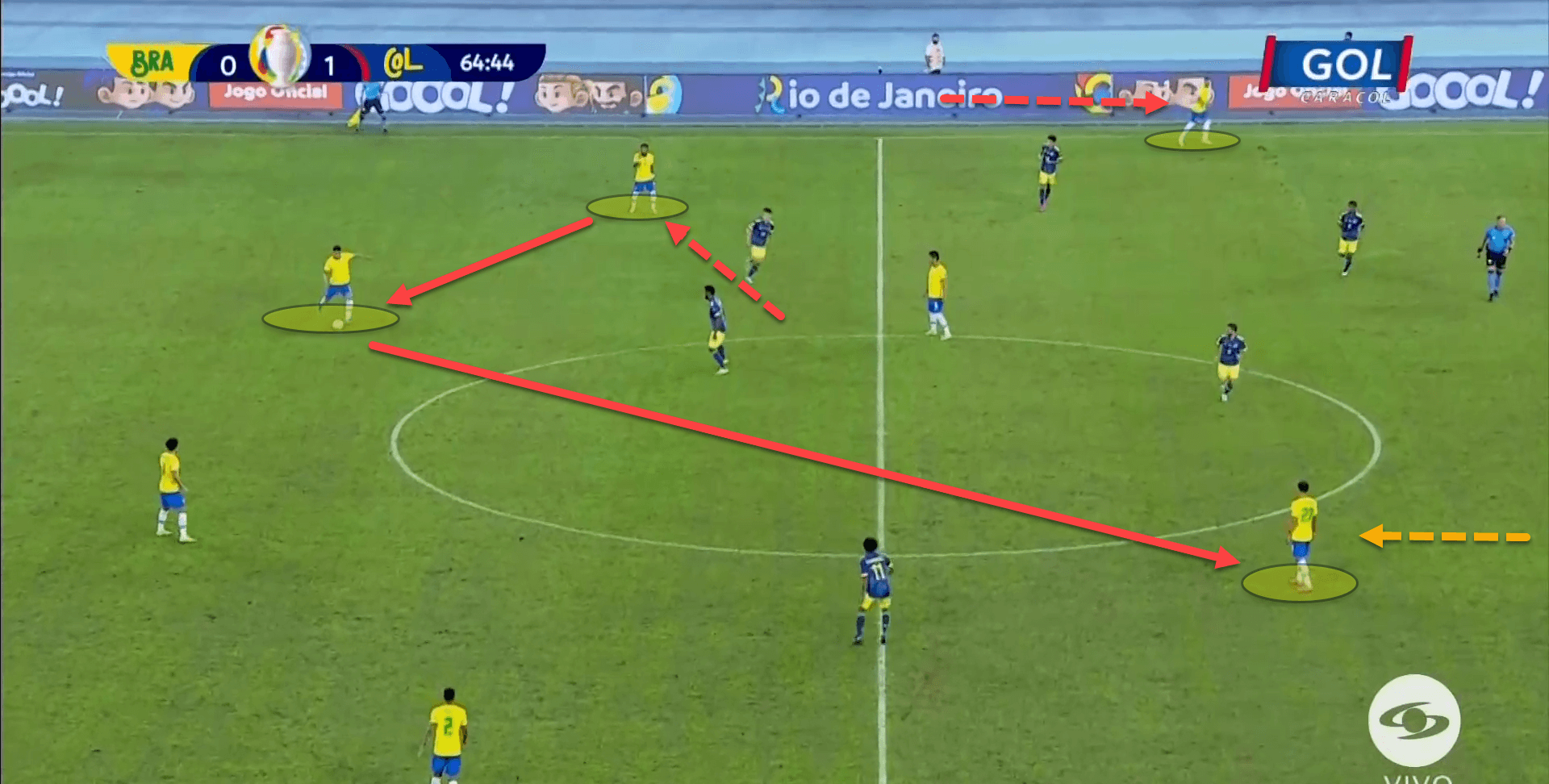
Here, Fred had the ball on the left flank which forced Colombia’s midfield to shift across to close him down and block off ball-near passing lanes. The Manchester United midfielder squared the ball to the left centre-back who quickly played to the feet of Roberto Firmino.
This subtle movement put Brazil into an advanced position on the field and gave Firmino the chance to take the ball on the half-turn and drive forward, potentially slipping a teammate in behind.
The second, and most important way that Fred dropping to the left flank helps the team is because Brazil can use their quality with the triangle it creates to break through down the flank and put crosses into the box.
There is no defensive structure that quality in-possession cannot break down.
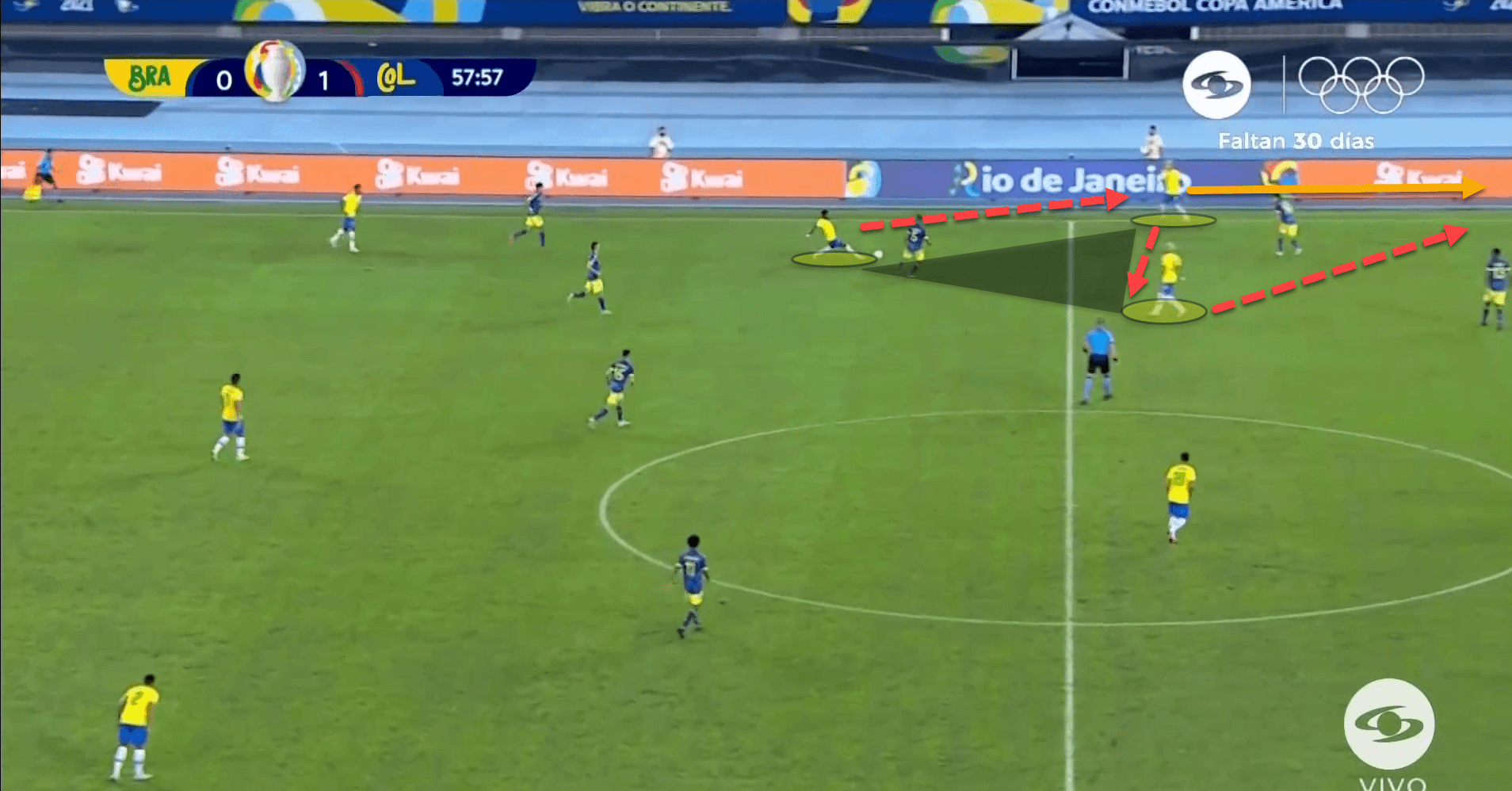
Here, Fred created a triangle out wide and the three players used quick combination play with quality to bypass Colombia’s pressure, getting the wide player in behind the opposition’s backline into a prime position for crossing.
As already stated, crossing is Brazil’s main source of chance creation and Chile. These crosses mainly come from the fullback on the left side regardless of whether Renan Lodi, Danilo, or Sandro are playing that position.
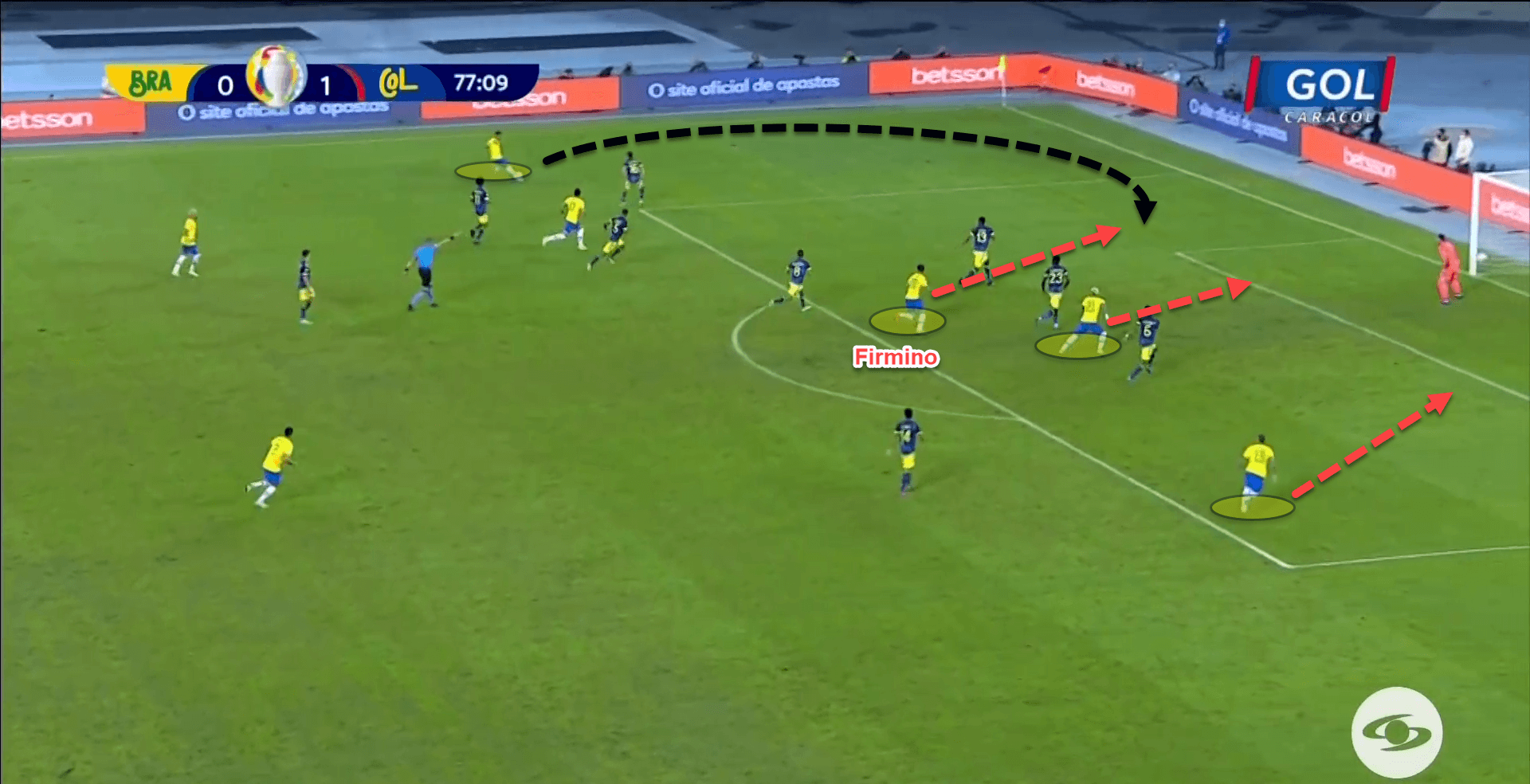
Here is an example of a goal scored by Firmino against Colombia in Brazil’s penultimate group game.
Chile must ensure that they can push out quick enough to close down the crosses and prevent them before the ball is put into the box. Of course, Lasarte’s men could also just make sure that they defend the crosses and clear them when they come into the penalty area, but it is better to try and cut the supply off at its source.
In the above example, Colombia’s fullback failed to close down or get his body close enough to stop the cross from Lodi and so the left-back put a fantastic ball into the box which was headed home by the Liverpool centre-forward.
Where can Chile hurt Brazil?
Brazil play a high line when they are in possession and even out of possession, they like to press the opposition in a high block so Chile may look to take advantage of this high line by using the pace that they possess in the forward department with Brereton and Vargas.
However, first, Chile must be able to break down Brazil’s pressing structure. Tite tends to deploy a 4-4-2 and in the high block phase, the shape resembles more of a 4-3-1-2 with one of the double-pivot pushing up to press the opposition’s deepest pivot player.
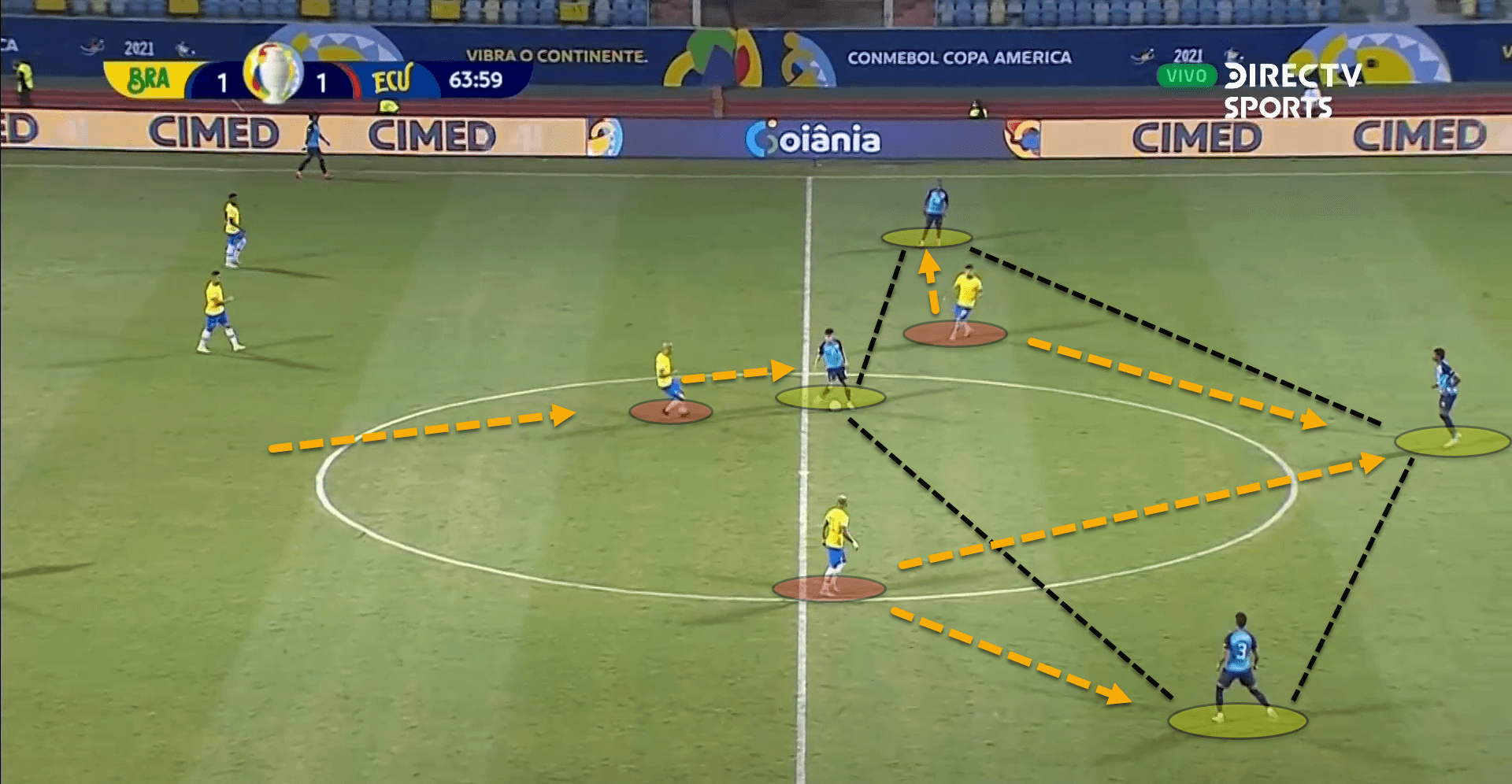
Here, against Ecuador’s 3-1 build-up structure, Brazil pressed the three centre-backs using their two centre-forwards whilst Fabinho pushed up to man-mark Chile’s single pivot. Brazil are outnumbered 4v3 in this situation but Brazil’s left centre-forward has cut the passing lane out to the right centre-back, meaning it is essentially a 3v3.
When playing with a 3-5-2/3-4-1-2, Chile use a 3-2 structure when looking to break the opposition’s first line of pressure.
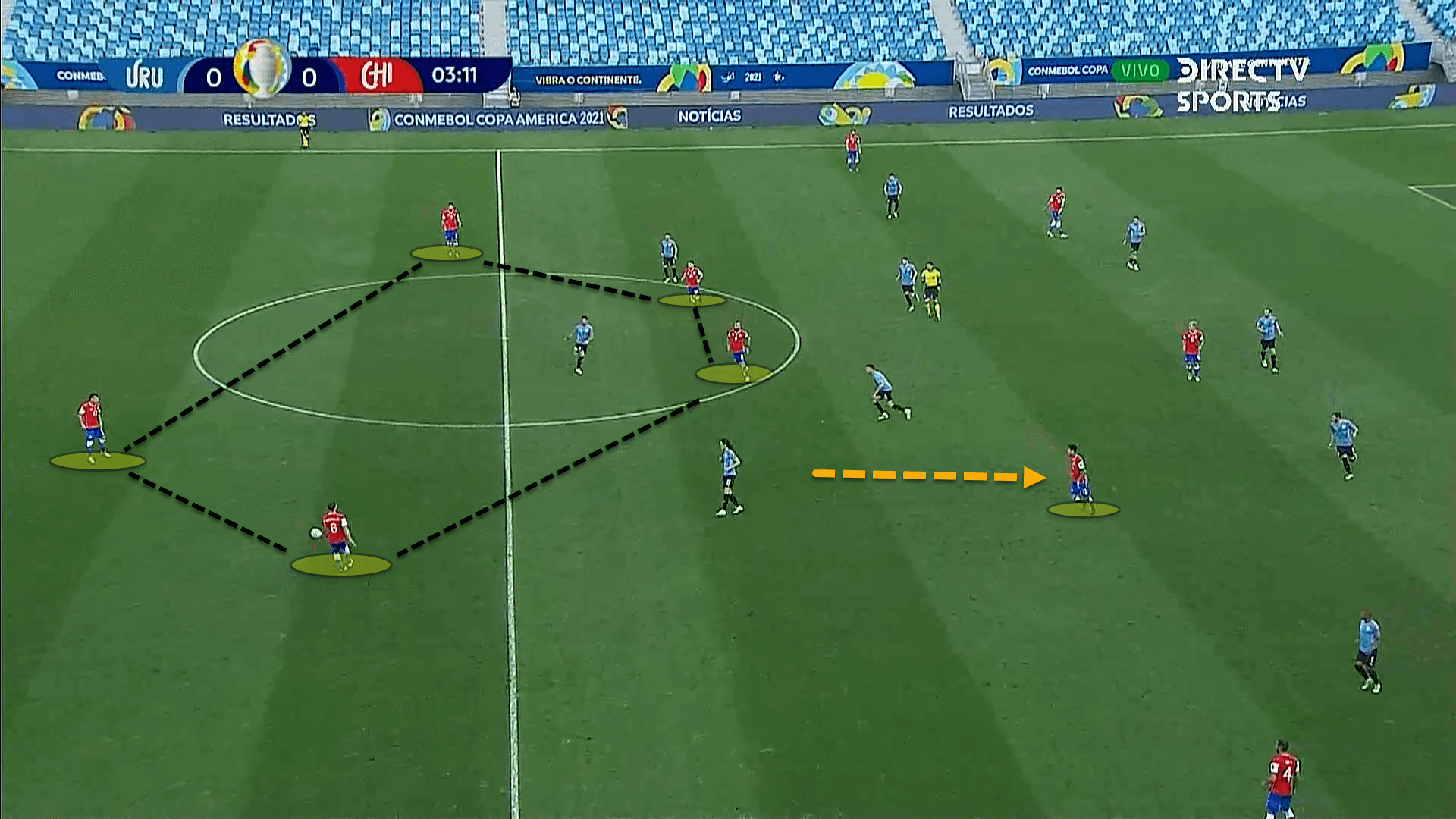
This could cause Brazil serious problems and could allow for easy progression from the Chileans to bypass the Brazilian press.
The reason for it is because the other Brazilian pivot player will be forced to push up to defend his opposite number, leaving one of Chile’s midfielders free between the lines to receive the ball in space.
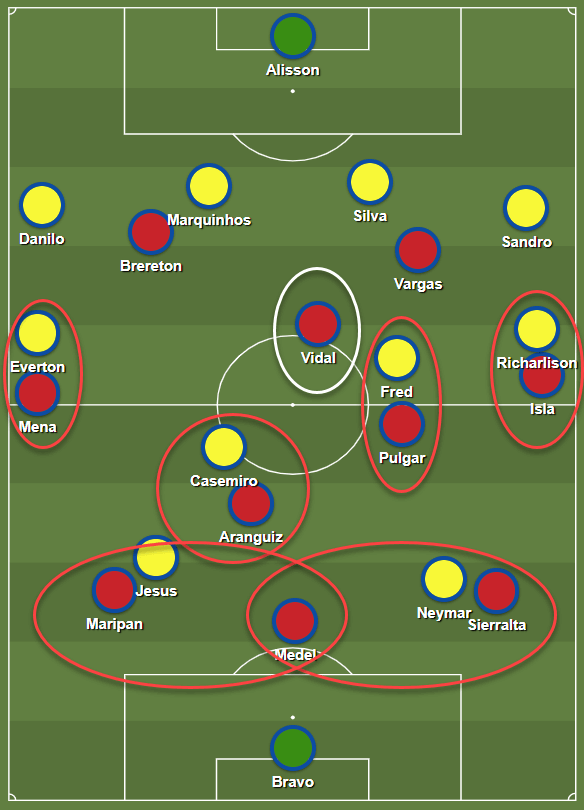
Vidal will most likely be the player in this optimal position behind the Brazilian midfield line and so this could be an efficient way for Chile to progress the ball up the pitch and through Brazil’s press.
Now that Chile have broken through the high-press through the midfield, they can finally exploit the high line played by Brazil. As already stated, they can do so by using runners with pace such as Brereton and Vargas to make forward runs into the channels.
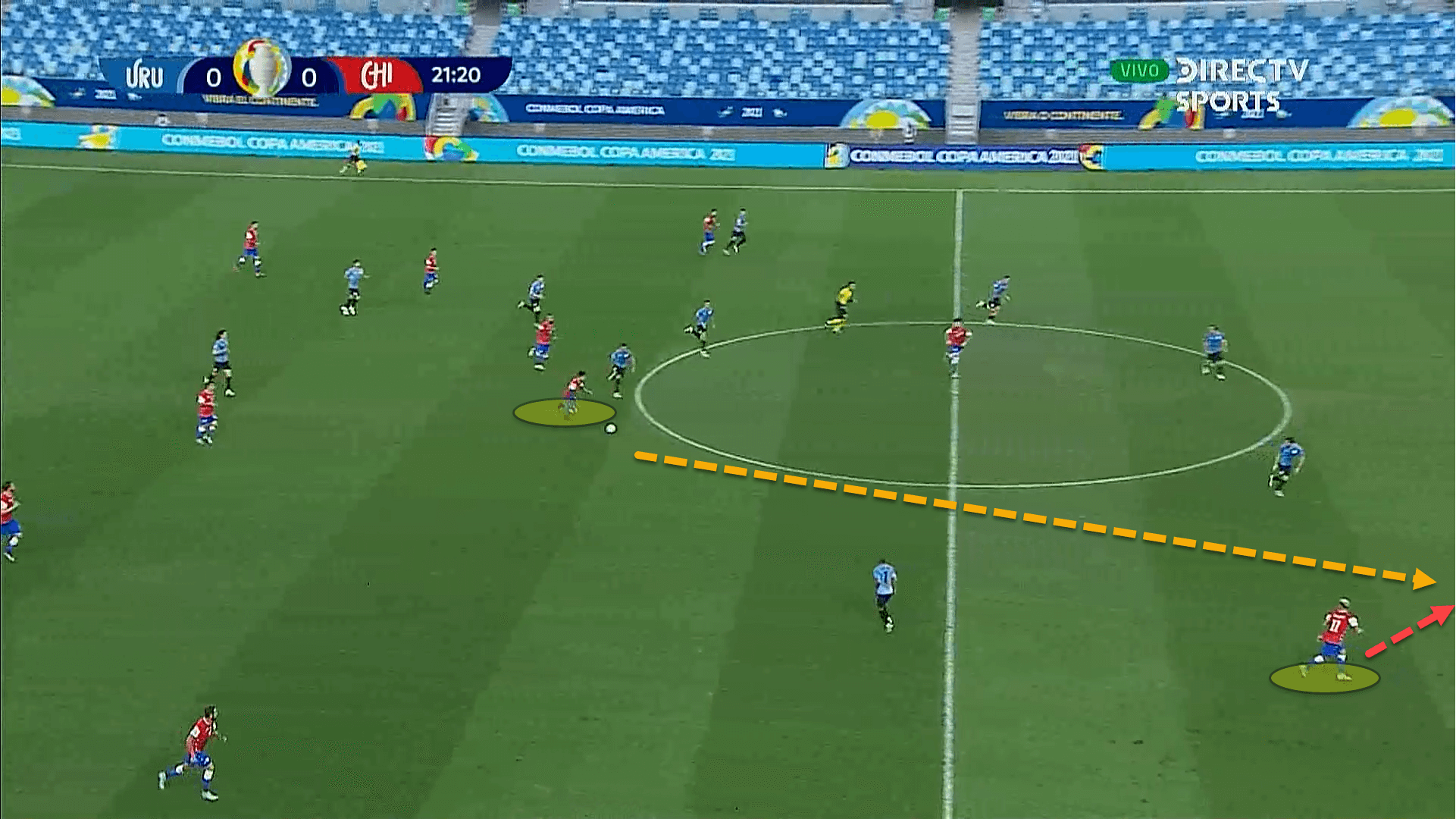
Here, Chile takes advantage of Uruguay’s high line with a quick ball from the midfield to Vargas who made a run down the channel. These passes need to be well-timed and precise but can cause serious damage to Brazil.
Conclusion
This game is likely to be exciting between two teams who play quite attacking football. Of course, Brazil are the overwhelming favourites but as football fans have seen from the recent Euros game between France and Switzerland, sometimes David beats Goliath.
Lasarte will need to ensure that his tactical game-plan is spot on to nullify the Brazilians’ attacking prowess and exploit their weaknesses whilst Tite must ensure that his side does not get complacent and that they stick to their game-plan to defeat the Chileans and progress to the semi-finals.




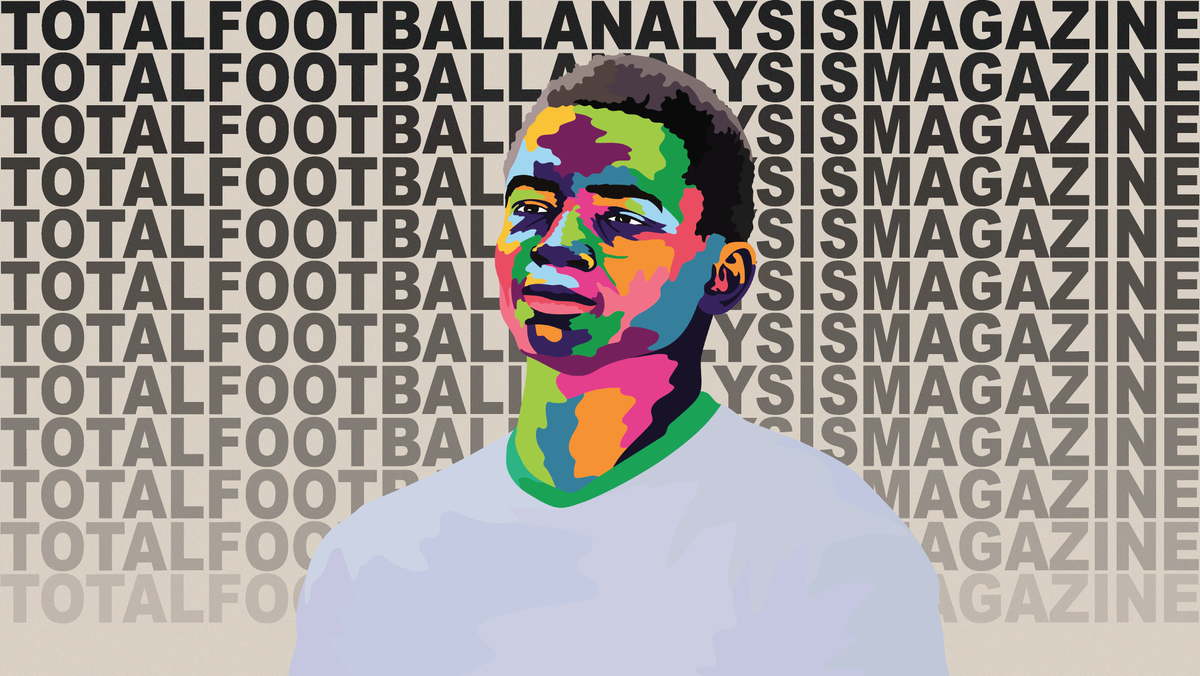

Comments